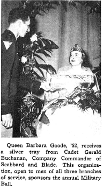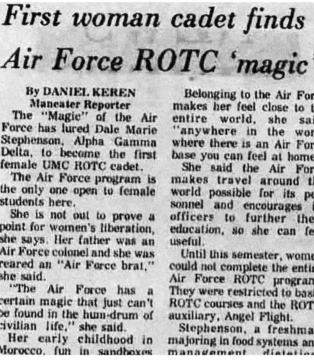Det 440 History
The Morrill Act of 1862 established Land Grant institutions and required these colleges to participate in the National Defense Program. A requirement of the act was that all male students take a course in basic military tactics. Mizzou was one of the first institutions to adopt the Morrill Act by creating the Missouri Military School.

The National Defense Act, passed in 1916, established the Reserve Officer's Training Program at schools and colleges throughout the United States. The program was created to develop trained leaders for times of national emergency and to teach military science and tactics on an equal footing with other academic subjects.

Impact of World Wars on MU AFROTC
One year after the establishment of the ROTC, the United States entered World War I. The number of students enrolled was heavily reduced as students and faculty left for military service or to work in war industries. Some fraternity and dormitory buildings were used as barracks for troops during training and instruction. Crowder Hall, named after the first commander of Army ROTC at the University of Missouri, was built in 1938 and became the headquarters for all military activity on campus.
After the United States declared war against Japan in 1941, the University of Missouri began to again undergo the drastic changes brought on by a nationwide war effort. Attendance at MU, which consisted of around 5,000 enrolled students in 1938, dropped to about 1,500 by 1943. Many students and faculty entered the service or left the University to help in other areas of the war effort.

Establishment of Air Force ROTC at MU
That year, the 307th College Training Detachment (Aircrew) brought an Air Corps Training program to the University of Missouri. After World War II, General Dwight D. Eisenhower signed General Order No. 124, establishing Air Force ROTC units at 78 colleges and universities throughout the nation, including the University of Missouri. With the birth of the Air Force in 1947, Air Force ROTC Detachment 440 was formally established at the University of Missouri in 1947 .
Evolution and Challenges of ROTC at MU
 All male students at MU were required to take two semesters of ROTC and Det 440 hosted about 300 cadets a year.
All male students at MU were required to take two semesters of ROTC and Det 440 hosted about 300 cadets a year.
ROTC functions were large and fashionable events on campus. Despite popularity among students, some objected to compulsory training. In 1961, petitioners collected more than 1000 signatures of those who wanted mandatory military training ended. However, Dr. Elmer Ellis, 13th president of the University, refused to consider changing the program. Conditions changed, though, in 1964, when Congress passed the ROTC Vitalization Act. It authorized scholarships for some cadets and monthly pay for all of them. It also eliminated the need to make ROTC training required.
ROTC at Mizzou faced opposition during the U.S. military presence in Vietnam. Cadets were often met by chanting protesters wielding antiwar signs in the halls of Crowder. Bolstered by the heroic service of Det 440 alums, such as Captain Douglas Frank Mahan, the program continued to develop excellent officers during those turbulent times.

Breaking Gender Barriers and Achievements at Det 440
An experimental program to commission women through Air Force ROTC was first conducted from 1956-1960. However, it was not until 1972 when Dale Marie Stevenson broke the gender barrier by becoming the first female cadet in Det 440.
To date, Detachment 440 has commissioned more than 900 cadets as second lieutenants into the United States Air Force. This program is proud to see its exemplary cadets pass through the doors of Crowder Hall on their way to becoming officers in the United States Air Force and now, Space Force.